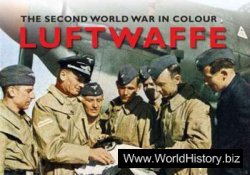The landing of 3rd Division at Sword and the capture of Caen was the most important event in Montgomery’s plan for D-Day. Between the offshore shoals and the estuary at Ouistreham, the beach itself at the little hamlet of la Breche d’Hermanville was wide enough only for one brigade at a time to come ashore, the first - 8th Brigade - at 07:25 to coincide with the landing at Gold. While the four brigades of 3rd Division fought their way inland towards Caen, Lovat’s commandos would cross the bridges at Benouville and reinforce 6th Airborne Division, which continued to receive glider reinforcements throughout the day. Problems of landing and stiff German resistance at Sword meant that Lovat arrived a few minutes late, but in good time to help secure the bridges against further German counterattacks.
The terrain at la Breche is explained by its name, which means “the breach”; a dip in the ground leading from the beach inland to the village of Hermanville. This proved irresistible to Maj. “Banger” King of the 2nd East Yorkshire Regiment, who went in with the first wave reciting “Once more unto the breach! “from Shakespeare’s Henry K while nearby a rescue launch played “Roll Out the Barrel” over its loudhailer. The first landings went well, with the first troops of 8th Brigade touching down one minute late, and nearly all the DD tanks and specialist armor, including the leading elements of 27th Armoured Brigade, reaching the beach safely. The strongpoints at la Breche itself were subdued by 10:00, and while the last of the German guns and machine guns were silenced, and the barbed wire entanglements cleared away, Lovat’s commandos (some of them on folding bicycles) pushed inland towards the waiting airborne troops. No. 4 Commando, including Commandant Kieffer’s force, moved eastward to secure Ouistreham. Kieffer’s men successfully assaulted the sea-front at Ouistreham, known as Riva-Bella, including a German strongpoint at the old casino. “All my fellow commandos,” one of Kieffer’s men mused, “idealists or madmen, saints or rogues, sailors or daredevils, united by a love of danger, are going back to where we started - France.” It was a small but important gesture: Gen. de Gaulle’s Fighting French had returned.
The bad weather showed little sign of abating, and as the morning wore on the rising tide reduced the narrow beach to a strip of sand only 10 yards (9m) from the seafront to the water’s edge. Engineers and frogmen trying to clear obstacles in the surf found themselves swept out to sea. Although infantry continued to land without much trouble, most of 3rd Division’s armor and vehicles were packed close together on the beach or waiting offshore to land, and the beach remained under fire. There was, remembered one tank officer, “a terrible jam on the beach where no organization appeared to be operating and no marked exits were to be seen.” With only one road off the beach, vehicles had to land at exactly the right spot.
Advancing only a short distance inland, many of the available tanks of 27th Armoured Brigade were drawn in to help the infantry fight their way past two German strongpoints, codenamed Morris and Hillman by the British, just beyond Hermanville and Colieville. A further brigade, 185th Brigade, was able to move off the beach soon after 11:00 as the spearhead of 3rd Divismn’s drive on Caen, but only by leaving most of its tanks and heavy weapons behind, to catch up as best they could. By late afternoon the leading troops of 185th Brigade had reached the villages of Beuville and Bieville, only two miles (3km) short of Caen itself The division’s last brigade, 9th Brigade, was still assembling, having disentangled itself from the beaches.
For a moment it seemed that Caen was within the British grasp. But by mid-afternoon the leading units of 185th Brigade started to report German tanks or assault guns emerging northwards from Caen, and German infantry on the Periers ridge north of the city. These were the leading troops of 21st Panzer Division, which the British had expected to find much further south. Without much armor support of their own, the infantry halted to engage the tanks, giving up any further advance.
It was the crisis of D-Day for British Second Army. Having checked the advance, the Germans were ready to launch their big attack to throw the British back into the sea. The two-mile (3km) gap between 3rd Division and 3rd Canadian Division was still not closed, and at 19:00 21st Panzer Division launched a charge of 50 tanks into it, trying to split the British landing in two. But 3rd Division were waiting for the PzKpfw IVs with artillery, fighter-bombers, and another surprise, the “Firefly”
Sherman, fitted with a 17-pounder anti-tank gun instead of the smaller 75mm gun of normal Shermans. In exercises back in England, the commander of 27th Armoured Brigade’s Staffordshire Yeomanry had analyzed the ground and the German plan. “They will form up their squadrons, give out their orders, then drive straight for their objective,” he had predicted. “What they do not know is that I have three troops of Fireflies which I will station on the Hermanville ridge and leave as a backstop.” Thirteen German tanks were knocked out for the loss of one British M-10 tank destroyer. It was an important lesson — the British might be slow in the advance, but they were almost unbreakable in defense.
Whether any of the German tanks actually reached the coast at Lion-sur-Mer along with their infantry is debatable. But just as the attack faltered, at 21:00 in the gathering dusk, there came one of those chance events by which battles are sometimes decided. Still trying to press forward, the German tank crews were astonished to see in the sky above them a force of over 250 British gliders, which swept over their heads like giant bats and came to land just behind them, close to Pegasus Bridge. This was the final fly-in of the day by 6th Airlanding Brigade, and by sheer coincidence it had arrived just in time to completely demoralize the German survivors, who pulled back towards Caen. The German threat to Sword, like the British threat to Caen, had been ended for the day.




 World History
World History









